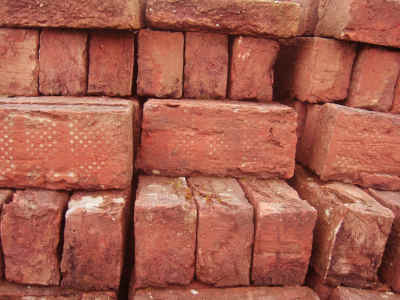How To Make Bricks

Here are the steps to making bricks using primitive techniques:
In a situation where you are trying to rebuild society the first order of business is survival. And any chance you get to eliminate repeating necessry task will give you more time to focus on other pressing task. So let's get started.
What is a brick? You may wonder what is the difference between a brick and pottery. For one, pottery is fired at a lower temperature than brick. Pottery is fired at temperatures between 700 and 1300°C (1292 to 2372°F). Where as brick is fired at temperatures between 932 to 1292°C (1710 to 2350°F). You probably noticed there is some overlap in firing temperatures.
Pottery is mostly clay with a little bit of sand mixed in 10-20 percent. While brick is mostly the same two ingredients the percent is different. Brick are made of more sand than clay.
Now back to the firing issue. It isn't quite as simple as it appears. This is because modern brick making techniques use specific ratios of two other components that help to lower the temperatures needed to successfully make a brick. These two components are lime and iron oxide.
Ideally bricks should contain a small amount of powdered lime. About 1 percent. Lime acts as a catalyst to elevate the furnace temperature to 1650C and fuse the sand.
Bricks also contain about 8% Iron Oxide. Iron Oxide acts a flux like lime, thus helps and helps the silica to fuse at low temperature.
You may be thinking that these two components will preclude you from making your own bricks. While it may prevent you from making traditional bricks if the lime and iron oxide can't be used it still doesn't prevent you from making a modified brick.
Try raising the clay content from the traditional amount to a higher percentage. Experiment. You will need thousands of bricks so experimenting isn't a huge issue. Raise the percentage of clay until you get something that is not water soluble. Simply place it in water overnight and see if it dissolves a little bit.
If it does you need to either up the clay content more or find a way to raise the firing temperature.
So, let's talk about firing your bricks. Placing them in an open fire is not going to be good enough. You will need to build a kiln (an oven) and fire it with charcoal. Both of which you can read about here (kiln) and here (charcoal). In a pinch and open fired brick is better than nothing. It won't be as durable as a brick from a higher temperature fire, but it is usable.
So if you haven't been scared off yet and you shouldn't be, the only thing left to talk about is making a form. Wet the form which will be made of wood most likely. It doesn't need to be fancy. Just make a form of the size you want to make. I suggest making your bricks larger than typical bricks for stability purposes. Build a wall 8 foot tall of regular size bricks and you will have issues with the wall wanting to simply fall over.
The bricks can be molded by hand or by using a simple wooden frame. A wooden frame helps with making the brick all the same size so I recommend using a form. Make your form of wood and wet it to keep the bricks from sticking to it too much. Add water to your brick mixture until it can be worked like dough. Fill your form with the clay sand mixture and then remove any excess. Drop the form and work out the clay and refill the form again. Allow the bricks to dry in the sun for a few hours until start to dry and firm up so that they can be flipped on their side. After a couple of days at least when they have dried more thoroughly then they can be stacked and allowed to dry for a couple of weeks before they can be fired.
Making bricks using primitive techniques is a simple process that has been used for thousands of years. With only a few basic tools and materials, anyone can make strong, durable bricks that can be used for construction projects.
